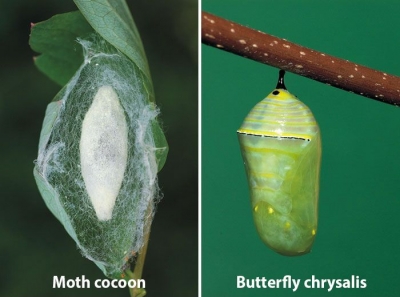
Life cycle refers to the development stages through a creature’s life. As you perhaps know already, the life cycle of most insects, including ants, wasps, bees, flies, butterflies and moths, consists of four stages – egg, larva, pupa and adult. This transformation is called metamorphosis. Metamorphosis is derived from the Greek word that means “to change shape”. Well after an adult lays eggs, the larvae or the caterpillars wiggle out. And they’re very hungry caterpillars! So at this stage, their singular purpose is to eat and grow. Depending on the species, what they feed on changes. For instance, the mosquito larvae usually feed on leaves. After growing considerably in size and shedding skin many times, the larvae pupate. During this stage, they have a protective covering, are attached to a surface, do not feed and the structures for adults are formed. Finally, adults emerge. It’s during the pupal stage that the question of chrysalis or cocoon comes up.
Chrysalis
Chrysalis refers to the pupal stage of a butterfly. Just before its final molting, the caterpillar attaches itself to a surface – usually a stem or under a leaf – using a tiny pad of silk that it spins. Some of these hanging caterpillars resemble letters such as C, J, etc. depending on the species. When it sheds its skin one last time, the new skin that emerges gradually becomes the outer covering for the chrysalis, which looks like a small lump of shimmer or plain colour. Inside this, slowly some parts of the caterpillar liquefy to give way to new organs. For instance, antennae and wings form while chewing mouthparts turn into sucking mouthparts to enable the butterfly to sip on nectar.
Cocoon
Cocoon is the hard covering spun usually by moth caterpillars. Before their last molting, the moth caterpillars spin these silky cases, and inside these, the caterpillars turn into pupae before emeriging as moths. Some of the caterpillars even add bits of dry leaves and tiny twigs to these cases for camouflage. Silk is obtained from the cocoon of the silk moth. Some of the insects too spin cocoons.
Not all the spinners!
It is said that butterflies never spin cocoons. However, there are apparently a few moth varieties too that do not build a cocoon. Instead they pupate underground – burrowing in the soil, molting into pupae and remaining burrowed until finally emerging out of the soil as moths.
Picture Credit : Google

